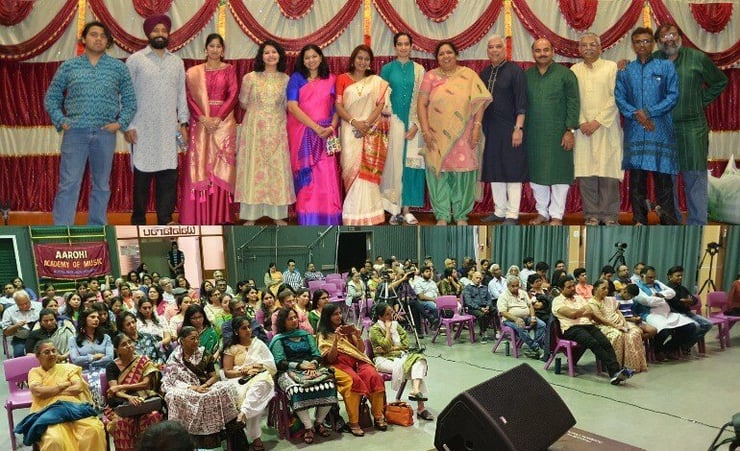Ras Bhav Rang – A tribute to Queens of Thumri

Aucklanders were treated to a kaleidoscope of a musical rainbow in Ras Bhav Rang, a tribute to the Queens of Thumri to mark the ongoing Holi festivities going around in different parts of New Zealand over the weekend.
Thumri is a vocal genre of Indian music – a unique art of singing based on classical Hindustani music – which initially emanated from the courts of Lucknow in the 19th-century princely state of Nawabs of Awadh.
.jpg) One of the unique features of this art form is the liberty it offers to the singer in moving between different Raags and emphasising the words and presentation.
One of the unique features of this art form is the liberty it offers to the singer in moving between different Raags and emphasising the words and presentation.
The singer not only sings but also emotes the Thumri – as the name suggests, “Thumakana” (movement of a maiden with dancing bells) through their facial expressions and body movements while performing, formulating instant connection with the audiences. This was clearly visible when a small gathering of passionate and dedicated music lovers was fully engrossed in the performances of several local talents who paid tribute to the legends of this genre.
.jpg)
The program was conceived and presented by Migrant Heritage Charitable Trust Inc (MigHT-i) and Aarohi Academy of Music. The quartet of Varsha Belwalkar, Prashant Belwalkar (MigHT-i) and Vidya Teke, Shekhar Teke (Aarohi) visualised the concept and presentation of this genre as it is often neglected by mainstream Hindustani Vocal presenters.
Speaking to the Indian Weekender Prashant Belwalkar said, “The program was a tribute to these greats and a humble salute to the those dedicated to the spread of Thumri even today.”
“The audiences were blessed to listen to some melodious Thumris that included Ghir Ghir aaye Badariya sari (Sardari Begum), Maine Lakho ke bol sahe, Balam tere, Rangi Sari chunariya, Jamane mein and the only duet thumri – Raah mein bhichi hai in the first half. These were presented by Daljeet Kaur, Kishori Telang, Vidya Teke, Dr Moushmi Das and Amrita Kaur,” Prashant said.
The second half was super treat with Saiyan rooth gaye, Koyaliya Na Bol, Saiyan Nikas gaye, Le na gai bemanua, Aae mohabbat tere anjam pe, Baju Band khul khul jaye and finale – Hamari Atariya pe.
A tribute to legends by local artists
The singers were competently supported by Samir Bhalodkar (Samvadini), Dr Malur (Violin), Manjeet Singh (Tabla) and Nikhil Ghate (Tabla).
Vidya Teke told the Indian Weekender that it was a long-held dream amongst the organisers to bring such a program dedicated to this particular genre of Indian classical music and finally came true last weekend.
Buoyed by the support and patronage received from the music lovers of Auckland, Varsha Belwalkar is excited to make this event an annual feature henceforth on the occasion of Holi as they explore other unique genres for the music-loving crowd of Auckland.
The program had the support of COGS, Tamaki Health and Saattveek.
More about Thumari
The genre has often been besmirched as the songs of Tawayafs (courtesans). However, it is far from the truth and had a grand run in the late 18th and early 19th century when the shahi darbars (royal courts) and nobility gave patronage to this art form.
It was popularised by yesteryear greats like Rasoolan bai, Siddeshwari Devi, Gauhar Jan (the most recorded artists once upon a time) and then the tradition continued later by greats like Begum Akhtar, Girija Devi, Kishori Amonkar, Prabha Atre, Shobha Gurtu, Farida Khanum and Nirmala Devi.
Even today, disciples of these greats, Shruti Sadolikar, Aarti Ankalikar, Shubha Mudgal, Shobha Joshi and the queen of melody Lata Mangeshkar have carried the tradition forward.




